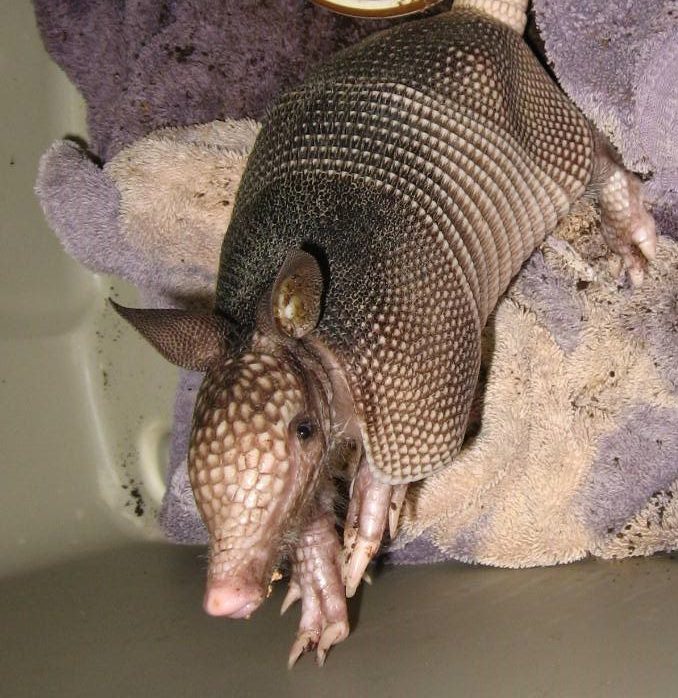Can an Armadillo Survive Being Hit by a Car
In recent years armadillos have become more common in Kansas. There are twenty different types of armadillos, but the only one in the Midwest is the nine-banded armadillo.
Interesting Facts
- Armadillos can hold their breath up to six minutes, which helps in foraging for their next meal when their nose is buried.
- Armadillos eat bugs, worms, slugs, frogs, lizards, and roadkill.
- The armadillo is nocturnal and can sleep up to 16 hours a day.
- Armadillos can smell food in soil that is eight inches deep. They have sticky fly-paper type tongues that help them to catch prey.
- Armadillos love water. They swim well and can fill their intestines with air so that they float or fill their intestines with water to sink to the bottom of a lake or stream.
- Armadillos don't have much of a bite. They only have about four teeth – small peg-like molars with no enamel and open roots.
- They have poor eyesight, but incredible senses of smell and hearing.
- Gestation of the embryos is 150 days. Armadillo mothers can delay implantation of a fertilized egg until environmental conditions are favorable for pregnancy.
- They are born pink with soft shells, like a human fingernail in texture, that gradually grow stronger by six months. At four months, they turn from pink to brown, making it easier to tell from a distance if an armadillo is a juvenile or adult.
- Armadillos have a low metabolic rate and low body fat, so they must forage for food daily, and they produce little body heat. This means they don't fare well in cold areas, because they can't keep warm. A few cold days in a row can be deadly to an armadillo.
- Since Kansas winters have been milder the last 10 years, they are slowly migrating north.
- Armadillos have been used in leprosy research. They also do not have a very strong immune system, making them an ideal model for many types of medical research.
- Having a built-in armored covering is helpful when an armadillo is running through thick, thorny brush, or sharp rocks in the tunnels they dig, and it provides some protection from the sun.
To rescue or not to rescue
If you find a baby armadillo, the best thing you can do for it is to leave it alone.

Fragile
Armadillo babies are EXTREMELY fragile, and they die very easily. If it is injured, call OWL immediately, and we can help advise on next steps. Please do not attempt to raise them on your own.

Create a barrier
Always wear gloves or use a towel or cloth as a barrier between yourself and the armadillo. They can carry diseases, including leprosy, that are transmittable to humans.
Cats
Cats have mouths full of bacteria that can kill an animal in a short time. All animals caught by a cat need to be brought in for medication and rehabilitation, even if you can't see wounds.
Dogs
If a dog brings you an animal bring it in immediately. Dogs have powerful jaws that can create crushing injuries.

What to do
Adults
Cars are the leading cause of death. Armadillos cannot roll themselves into a ball. The bony plates make up their hard shell prevent them from being able to roll up. Instead of rolling into a round defense posture when threatened, they have a fright response that causes them to jump – straight up.
This strategy works well against a fox or a coyote. But this defense mechanism fails miserably when it comes to cars. The jump response positions the armadillo to be hit by the car.
Signs of Injury
If you notice any of these issues, call OWL as soon as possible:
- Cold and lethargic.
- Covered with fleas, ants, ticks, or flies/flystrike (looks like small clusters of rice anywhere on the animal).
- Dehydrated.
- Has been in a cat's or dog's mouth.
- Broken limb, cuts, or bruises.
- Has been fed any kind of formula or food.
- Head tilt.
- Bleeding.
- Unable to stand or move without falling over.
Common Concerns
Most armadillo damage occurs because they root in lawns, golf courses, vegetable gardens, and flower beds. Signs of armadillo activity are shallow holes, 1 to 3 inches deep and 3 to 5 inches wide, which they dig in search for food. They also uproot flowers and other plants.
The best defense against armadillos digging up the yard is a good offense. These animals are built for digging and burrowing. Fencing and other barriers may work but need to be installed with a portion buried under the ground to prevent armadillos from just digging under.
If you already have a fence in place and they are already digging under it, you can purchase metal tent stakes, lawn stakes, or even rebar poles and drive them into the ground right at the fence line.
Armadillos are diggers. The best solution for this is to exclude the animal and install a one-way door. These doors can be found on www.livetrap.com or you can hire a company to build the exclusion and install the one-way door for you. These doors allow the animals to get out, but not back in.
DO NOT TRAP during the months of April, May and June because there may be babies present, and you don't want to trap them in when trying to catch mom.
After you're sure the armadillo has vacated, fill in the hole with loose soil, wait 48 hours to see if there is any movement, and then seal the hole with more dirt mixed with pea gravel
The First Treatment for Shock or Injury: Warm, Dark, and Quiet
If you need to bring an animal into OWL, the most important thing you must do is to keep them warm and quiet.
Container
Put in a shoebox or other container with several small air holes in the lid and a non-terrycloth towel, fleece cloth, or t-shirt in the bottom. Tape the lid to keep secure.
Adult animals need to be contained in a dog or cat carrier.
Heating Pad
If you have a heating pad, set to low and place the box half on/off the pad, so the animal can move away from the heat if needed.
Rice Bag
Fill a sock or knee-high pantyhose with uncooked dry rice. Microwave the rice-filled sock for 30 to 60 seconds. This heat source will last about 20 to 30 minutes. Place the rice sock in the container under the towel, and place the animal on or near it, but not directly in contact with the rice sock.
Ziploc bag
Fill a bag with warm (not hot) water, put it inside another bag, and place under the towel next to the animal. The double bag guards against leaks and prevents the animal from getting wet and chilled.
Food/Water
Do not attempt to feed or give anything to drink. The wrong foods can quickly cause enteritis (diarrhea) and death. Keeping the animal warm is more important than feeding it.

Can an Armadillo Survive Being Hit by a Car
Source: https://owl-online.org/animal-guide/armadillo/
0 Response to "Can an Armadillo Survive Being Hit by a Car"
Post a Comment